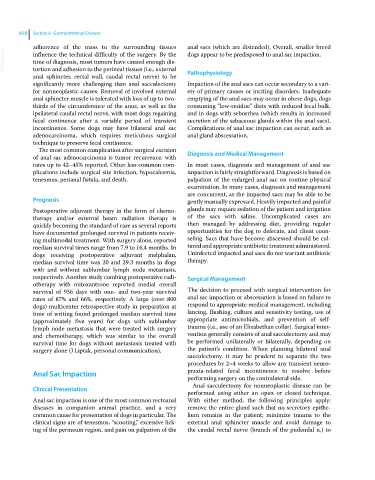Page 642 - Clinical Small Animal Internal Medicine
P. 642
610 Section 6 Gastrointestinal Disease
adherence of the mass to the surrounding tissues anal sacs (which are distended). Overall, smaller breed
VetBooks.ir influence the technical difficulty of the surgery. By the dogs appear to be predisposed to anal sac impaction.
time of diagnosis, most tumors have caused enough dis-
tortion and adhesion to the perineal tissues (i.e., external
anal sphincter, rectal wall, caudal rectal nerve) to be Pathophysiology
significantly more challenging than anal sacculectomy Impaction of the anal sacs can occur secondary to a vari-
for nonneoplastic causes. Removal of involved external ety of primary causes or inciting disorders. Inadequate
anal sphincter muscle is tolerated with loss of up to two‐ emptying of the anal sacs may occur in obese dogs, dogs
thirds of the circumference of the anus, as well as the consuming “low‐residue” diets with reduced fecal bulk,
ipsilateral caudal rectal nerve, with most dogs regaining and in dogs with seborrhea (which results in increased
fecal continence after a variable period of transient secretion of the sebaceous glands within the anal sacs).
incontinence. Some dogs may have bilateral anal sac Complications of anal sac impaction can occur, such as
adenocarcinoma, which requires meticulous surgical anal gland abscessation.
technique to preserve fecal continence.
The most common complication after surgical excision
of anal sac adenocarcinoma is tumor recurrence, with Diagnosis and Medical Management
rates up to 42–45% reported. Other less common com- In most cases, diagnosis and management of anal sac
plications include surgical site infection, hypocalcemia, impaction is fairly straightforward. Diagnosis is based on
tenesmus, perianal fistula, and death. palpation of the enlarged anal sac on routine physical
examination. In many cases, diagnosis and management
are concurrent, as the impacted sacs may be able to be
Prognosis gently manually expressed. Heavily impacted and painful
Postoperative adjuvant therapy in the form of chemo- glands may require sedation of the patient and irrigation
therapy and/or external beam radiation therapy is of the sacs with saline. Uncomplicated cases are
quickly becoming the standard of care as several reports then managed by addressing diet, providing regular
have documented prolonged survival in patients receiv- opportunities for the dog to defecate, and client coun-
ing multimodal treatment. With surgery alone, reported seling. Sacs that have become abscessed should be cul-
median survival times range from 7.9 to 16.4 months. In tured and appropriate antibiotic treatment administered.
dogs receiving postoperative adjuvant melphalan, Uninfected impacted anal sacs do not warrant antibiotic
median survival time was 20 and 29.3 months in dogs therapy.
with and without sublumbar lymph node metastasis,
respectively. Another study combing postoperative radi- Surgical Management
otherapy with mitoxantrone reported medial overall
survival of 956 days with one‐ and two‐year survival The decision to proceed with surgical intervention for
rates of 87% and 66%, respectively. A large (over 800 anal sac impaction or abscessation is based on failure to
dogs) multicenter retrospective study in preparation at respond to appropriate medical management, including
time of writing found prolonged median survival time lancing, flushing, culture and sensitivity testing, use of
(approximately five years) for dogs with sublumbar appropriate antimicrobials, and prevention of self‐
lymph node metastasis that were treated with surgery trauma (i.e., use of an Elizabethan collar). Surgical inter-
and chemotherapy, which was similar to the overall vention generally consists of anal sacculectomy and may
survival time for dogs without metastasis treated with be performed unilaterally or bilaterally, depending on
surgery alone (J Liptak, personal communication). the patient’s condition. When planning bilateral anal
sacculectomy, it may be prudent to separate the two
procedures by 2–4 weeks to allow any transient neuro-
Anal Sac Impaction praxia‐related fecal incontinence to resolve before
performing surgery on the contralateral side.
Anal sacculectomy for nonneoplastic disease can be
Clinical Presentation
performed using either an open or closed technique.
Anal sac impaction is one of the most common rectoanal With either method, the following principles apply:
diseases in companion animal practice, and a very remove the entire gland such that no secretory epithe-
common cause for presentation of dogs in particular. The lium remains in the patient; minimize trauma to the
clinical signs are of tenesmus, “scooting,” excessive lick- external anal sphincter muscle and avoid damage to
ing of the perineum region, and pain on palpation of the the caudal rectal nerve (branch of the pudendal n.) to

